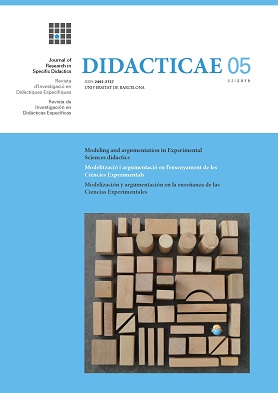El cicle de modelització com a eina d'anàlisi d'una unitat didàctica sobre energia
The modelling cycle as an instrument to analyze a teaching sequence on energy
DOI:
https://doi.org/10.1344/did.2019.5.43-56Keywords:
school scientific models, modelling, energy, secondary education, design of teaching sequencesAbstract
In this research we reflect on how the modelling cycle proposed by Couso and Garrido-Espeja (2017) for the design of teaching sequences can be used to analyse how a teaching and learning sequence tries to promote modelling. The teaching sequence “Energy and emotions” addresses the energy model (transfer, conservation and degradation of energy) and is part of a larger curricular project titled ‘Scientific thinking competencies. Science 12-15'. This teaching and learning sequence was designed to promote modelling in a contextualized teaching approach. However, there are several ways to conceptualise and promote modelling as a scientific practice in the science class. In this sense, the modelling cycle of our framework has been a useful tool for analysing the activities around key ideas of the energy model proposed in the design of the teaching and learning sequence. As a result of this analysis, we have found that the teaching sequence contains many activities that promote the evaluation of key ideas of the model among students by obtaining further evidence or deepening in the exploration of the phenomena. Instead, activities promoting structuring ideas are not so frequent since there are few ones that motivate the expression and consensus of a final model.
References
Aliberas, J., Izquierdo, M., i Guitart, F. (2015). El context per aprendre química en el projecte «Competències de pensament científic ESO 12-15». Educació Química EduQ, 20, 32–39.
Baek H., Schwarz C., Chen J., Hokayem H., i Zhan L. (2011) Engaging Elementary Students in Scientific Modeling: The MoDeLS fifth-grade approach and findings. En M. Khine i I. Saleh (Eds.) Models and modeling. Models and modeling in Science education, vol. 6 (pp. 195-218). Netherlands, Dordrecht: Springer.
Brandsford, J. D., Brown, A. L., i Coching, R. R. (1999). How people learn. Brain, mind, experience and school. National Academy Press: Washington, D.C. https://doi.org/10.1016/B978-0-88415-752-6.50153-3
Couso, D. (2014). De la moda de “aprender indagando” a la indagación para modelizar: una reflexión crítica. 26EDCE. Investigación y Transferencia Para Una Educación En Ciencias: Un Reto Emocionante, 1–28.
Couso, D., i Garrido-Espeja, A. (2017). Models and modelling in pre-service teacher education: Why we need both. En K. Hahl, K. Juuti, J. Lampiselkä, A. Uitto, i J. Lavonen (Eds.), Cognitive and affective aspects in science education research. Selected Papers from the ESERA 2015 Conference (Springer, pp. 245–261).
Crujeiras, B., i Jiménez-Aleixandre, M. P. (2012). Participar en las prácticas científicas. Alambique, 72, 12–19.
Duschl, R. A., i Grandy, R. (2012). Two views about explicitly teaching nature of Science. Science and Education, 22(9), 2109–2139. doi: https://doi.org/10.1007/s11191-012-9539-4
Garrido Espeja, A. (2016). Modelització i models en la formació inicial de mestres de primària des de la perspectiva de la pràctica científica. Universitat Autònoma de Barcelona, Bellaterra.
Gutiérrez, R. (2014). Lo que los profesores de ciencia conocen y necesitan conocer acerca de los modelos. Aproximaciones y alternativas. Bio-Grafía, 7(13), 37–66. doi: https://doi.org/10.17227/20271034.13biografia37.66
Harlen, W. (2010). Principles and big ideas of Science education (Vol. 1). doi: https://doi.org/10.1017/CBO9781107415324.004
Hernández, M. I., Couso, D., i Pintó, R. (2015). Analyzing students’ learning progressions throughout a teaching sequence on acoustic properties of materials with a model-based inquiry approach. Journal of Science Education and Technology, 24(2–3), 356–377. doi: https://doi.org/10.1007/s10956-014-9503-y
Izquierdo-Aymerich, M., i Adúriz-Bravo, A. (2003). Epistemological foundations of school science. Science & Education, 12, 27–43. doi: https://doi.org/10.1023/A:1022698205904
Izquierdo, M. (2014). Los modelos teóricos en la enseñanza de las ciencias para todos. Bio-Grafía, 13, 69–85.
Izquierdo, M., Espinet, M., García, M. P., Pujol, R. M., i Sanmartí, N. (1999). Caracterización y fundamentación de la ciencia escolar. Enseñanza de Las Ciencias, número extra, 79–91.
López, V., i Pintó, R. (2012). Ensenyar energia a secundària. Recursos de Física, 9, 1–9.
Millar, R. (2005). Teaching about energy. Physics Education, 18(2), 55–56. doi: https://doi.org/10.1088/0031-9120/18/2/101
National Research Council. (2012). A framework for K-12 science education. Social Sciences. https://doi.org/10.17226/13165
Neumann, K., Viering, T., Boone, W. J., i Fischer, H. E. (2013). Towards a learning progression of energy. Journal of Research in Science Teaching, 50(2), 162–188. doi: https://doi.org/10.1002/tea.21061
Ogborn, J. (1986). Energy and fuel: The meaning of “The Go of Things.” School Science Review, 68(242), 30–35.
Oh, S. P., i Oh, S. J. (2011). What teachers of Science need to know about models: An overview. International Journal of Science Education, 33(8), 1109–1130.
Osborne, J. (2014). Teaching scientific practices: Meeting the challenge of change. Journal of Science Teacher Education, 25, 177–196.
Pintó, R. (2004). ¿Qué modelo de energía deseamos que construyan nuestros estudiantes de secundaria? Alambique, 42, 41–54.
Schwarz, C. V., Reiser, B. J., Davis, E. A., Kenyon, L., Achér, A., Fortus, D., Shwartz, Y., Hug, B., i Krajcik, J. (2009). Developing a learning progression for scientific modeling: Making scientific modeling accessible and meaningful for learners. Journal of Research in Science Teaching, 46(6), 632–654. doi: https://doi.org/10.1002/tea.20311
Soto, M., Couso, D., López, V., i Hernández, M. I. (2017). Promoviendo la apropiación del modelo de energía en estudiantes de 4o de ESO a través del diseño didáctico. Ápice. Revista de Educación Científica, 1(1), 90–106.
Downloads
Published
Issue
Section
License
Copyright (c) 2019 Caterina Solé

This work is licensed under a Creative Commons Attribution-ShareAlike 4.0 International License.
The authors who publish in this journal agree to the following terms:
- Authors retain copyright and grant the journal the right of first publication.
- Submitting a paper does not involve paying any fees.
- Texts will be published under a Creative Commons Attribution Share-Alike 4.0 International License that allows others to share the work, provided they include an acknowledgement of the work’s authorship, its initial publication in this journal and the terms of the license.
- When citing works published in Didacticae, both the autor and the journal must be cited.
- Didacticae does not accept any responsibility for the points of view and statements made by the authors.



